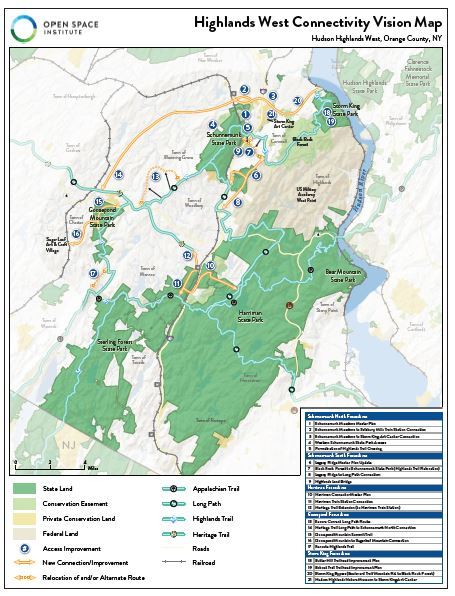
Trail Connectivity Plan Envisions a Protected Green Corridor, Improved Access to Nature
Title

Body
The Highlands West Trail Connectivity Plan aims to protect the routes of four long-distance trails through six New York State Parks.
The Trail Conference is proud to partner with the Open Space Institute and the Orange County Land Trust on the Highlands West Trail Connectivity Plan, a long-term initiative to conserve open space and support accessible outdoor recreation in New York’s western Hudson Highlands region. The plan establishes a regional vision for recreation, conservation, and local economic development in a region that has seen increasing residential, commercial, and industrial development pressures.
Unveiled Feb. 22, the plan highlights a range of opportunities to permanently protect and enhance the landscape, working toward the creation of a connected, regional trail network. This green corridor will provide recreational opportunities for residents and visitors, protect critical wildlife habitat, and safeguard local watersheds. It strategically coordinates partners to identify, acquire, and protect parcels in eastern Orange County in a way that ensures permanently preserved routes for long-distance trails—the heart of the Trail Conference’s conservation efforts for decades. It is, in fact, the four major long-distance trails that converge in the western Hudson Highlands—the Appalachian Trail, Long Path, Highlands Trail, and Orange County Heritage Trail—that serve as the basis and inspiration for this expanded and enhanced network.
Ultimately, six state parks— from Storm King in the north to Sterling Forest in the south—would be connected through this plan. Spanning more than 93,000 acres, the area also includes Harriman, Bear Mountain, Goosepond Mountain, and Schunnemunk state parks, as well as privately protected lands such as Black Rock Forest and Storm King Art Center.
The Highlands West Trail Connectivity Plan includes recommendations that will make access to outdoor spaces more widely available. Already, many recreational opportunities in the area exist within a one-hour drive or train ride from New York City. The plan proposes new trail connections that will link popular town centers, train stations, and bus stops to nearby state parks and protected lands.
“It’s easy to focus on building new sections of trail, but this plan demonstrates the type of big-picture thinking needed to make smaller projects into something greater than the sum of their parts,” says Peter Dolan, Trail Conference Trail Program Manager. “By connecting preserved lands and ensuring public access along them, we seek to create long-distance trails that open up brand new ways for people to connect with nature. Perhaps someday, thanks to this plan, residents of the Hudson Highlands will look at the Highlands Trail and Long Path with the same recognition and reverence that the Appalachian Trail enjoys.”
The Hudson Highlands West Trail Connectivity Plan is the product of more than two years of planning, meetings, and interviews. Stakeholders including elected officials, nonprofit organizations, and state and local agencies were consulted to develop a regional vision and identify opportunities for meaningful open space protection and trail linkages. It builds on the progress the Trail Conference has made over the last several decades preserving land from Sterling Forest east toward Storm King.
Proposed projects include new trail creation; realignment and safety improvements for existing trails; planning for new park and trail areas to help reduce crowding at more popular state parks in the area; and trailhead improvements at existing parks to better welcome and direct visitors. Information on these projects, the Trail Conference’s involvement, and ways to get involved will be posted at nynjtc.org.
Read the full Hudson Highlands West Trail Connectivity Plan.
